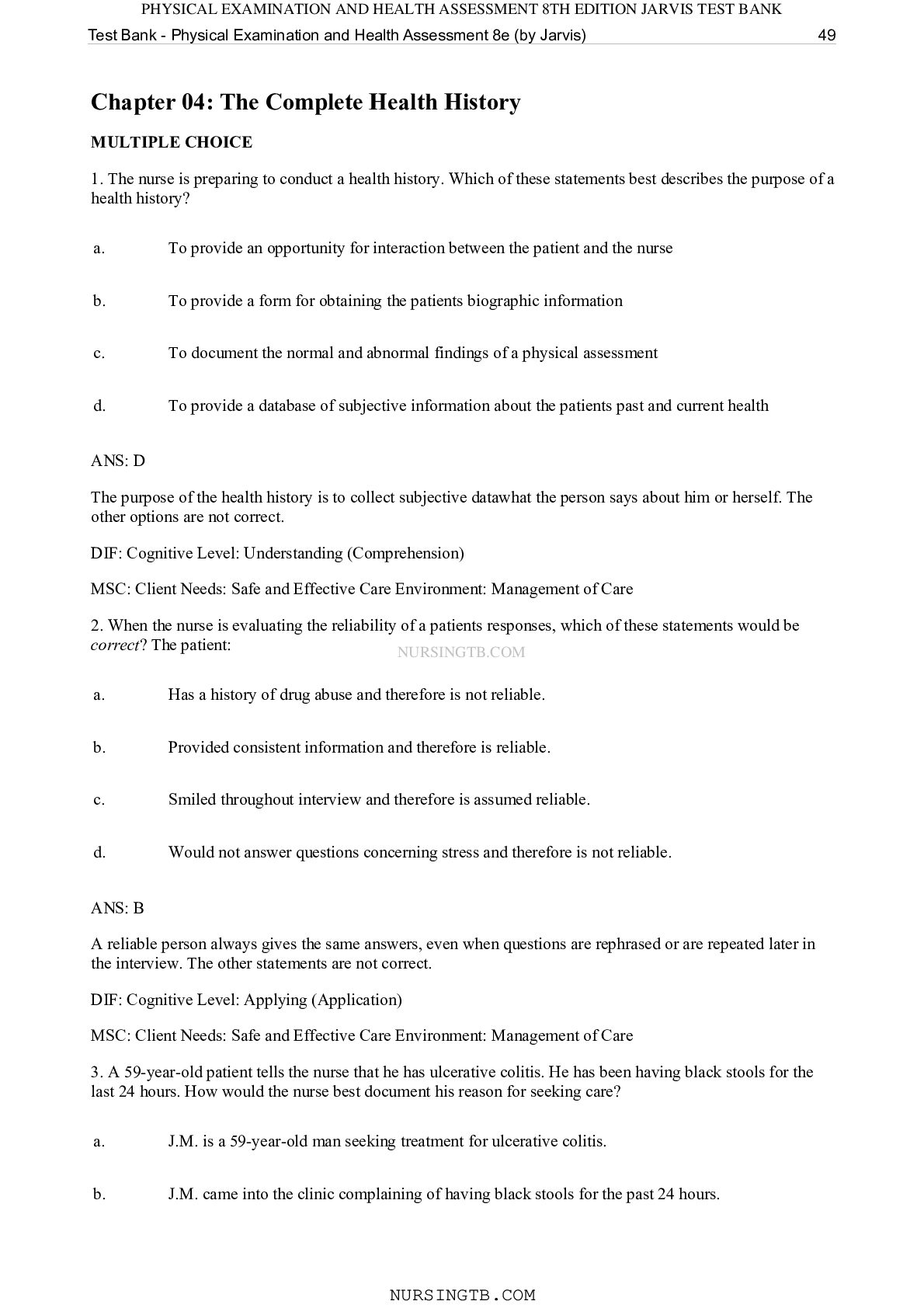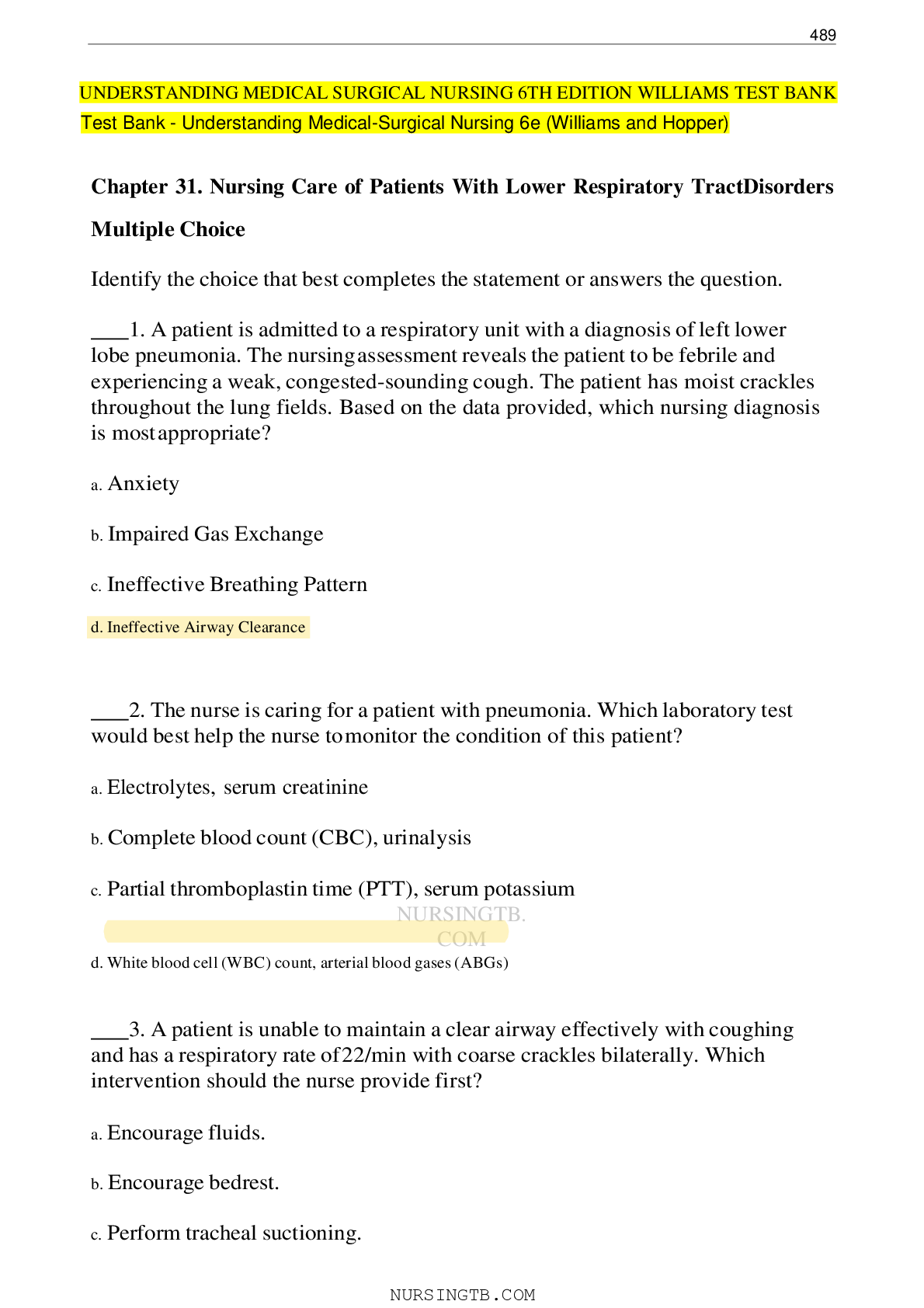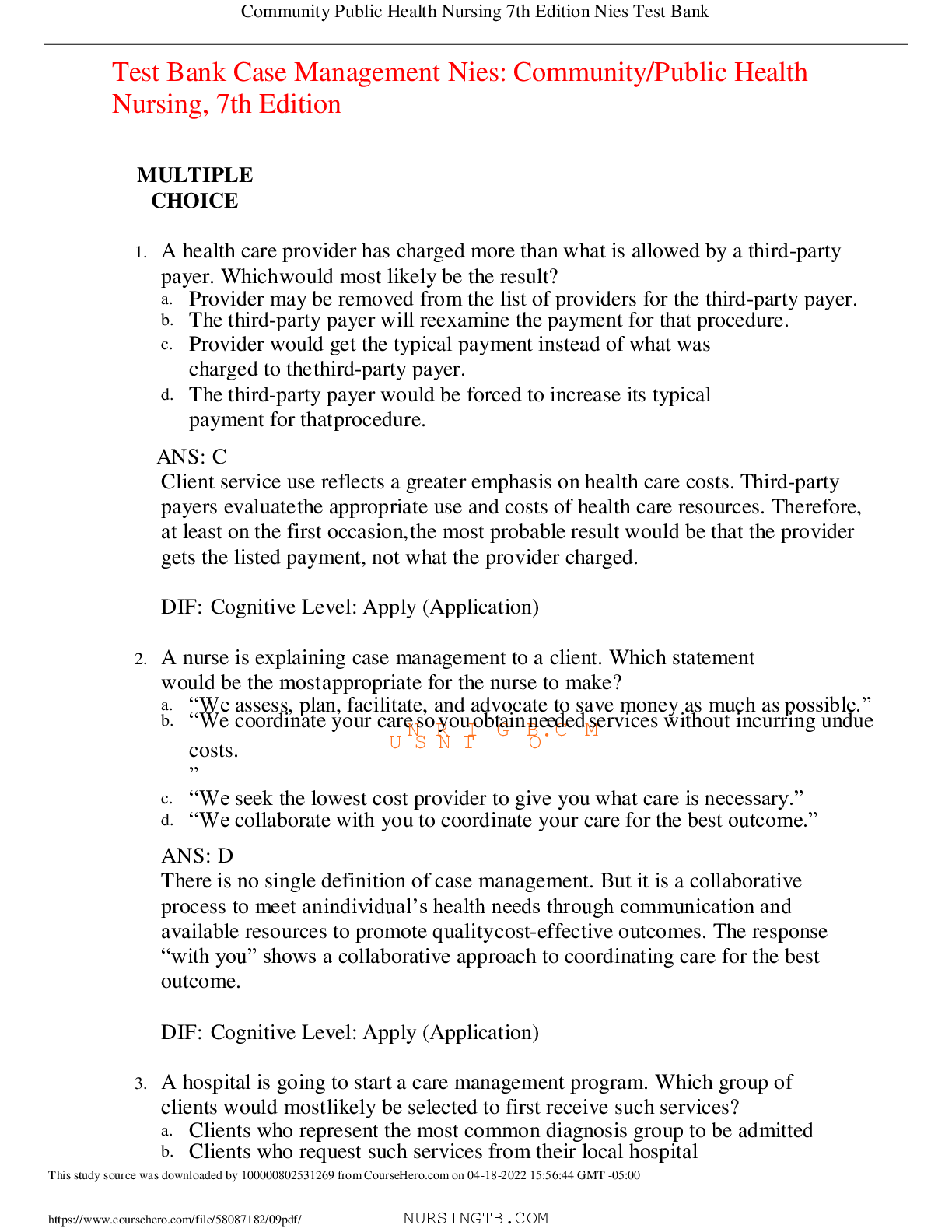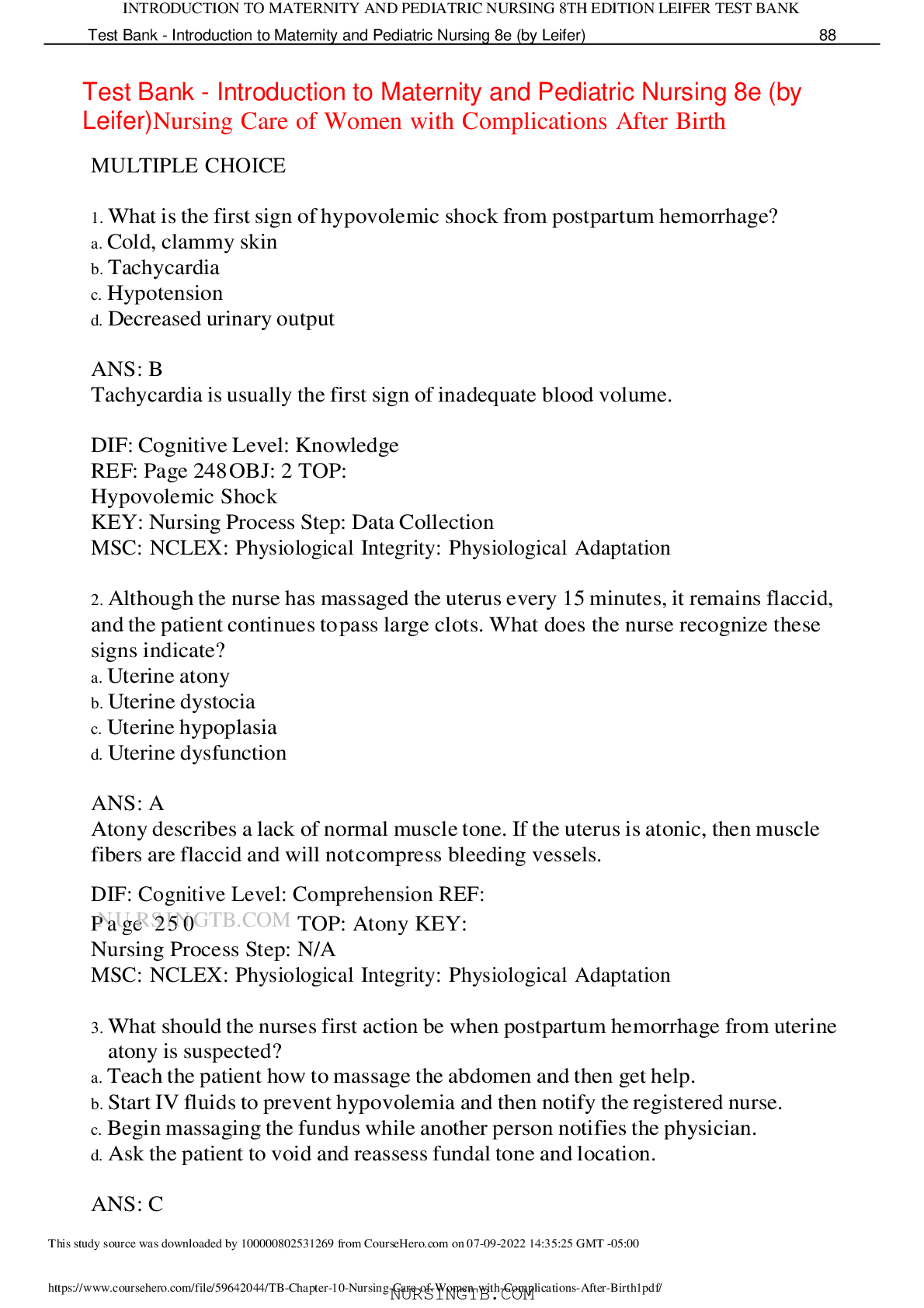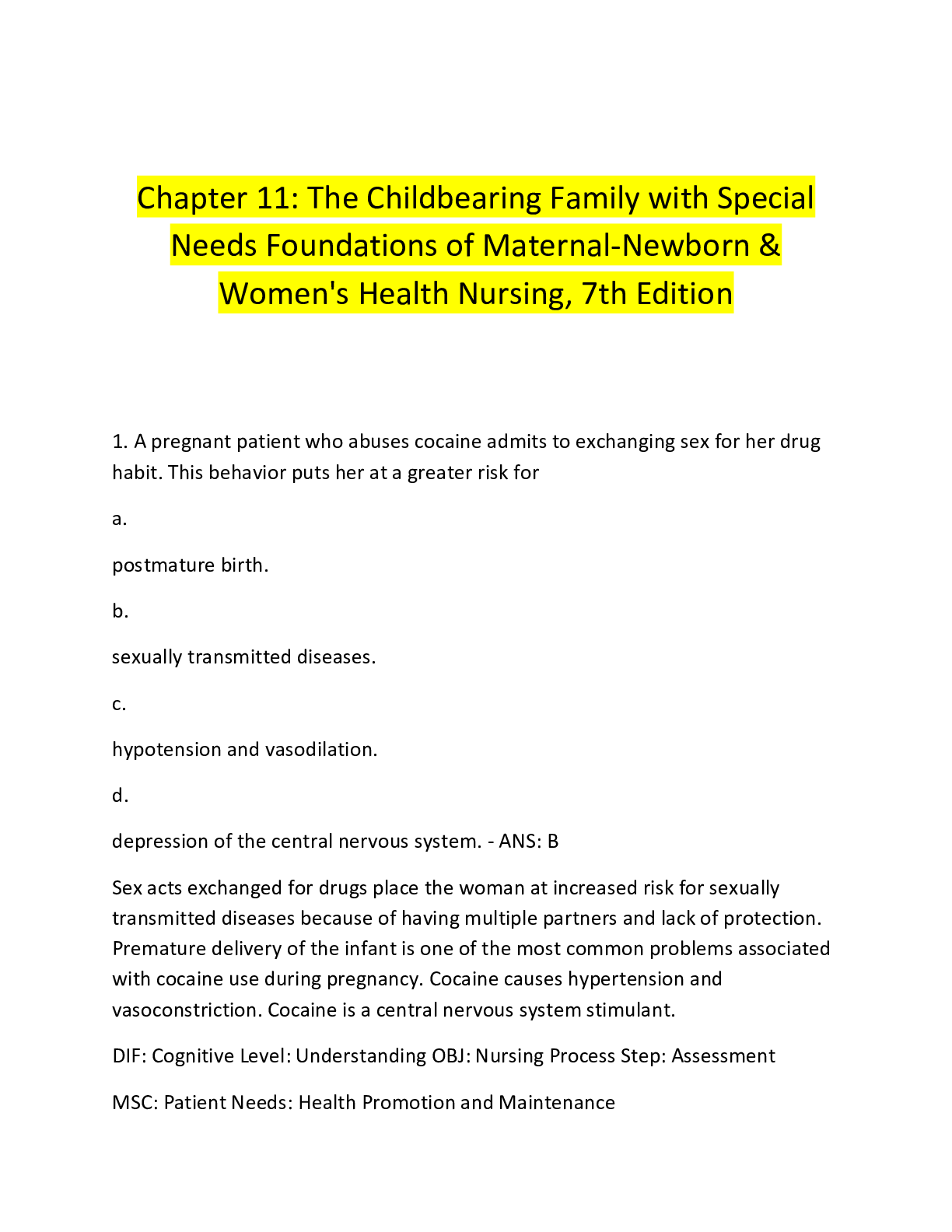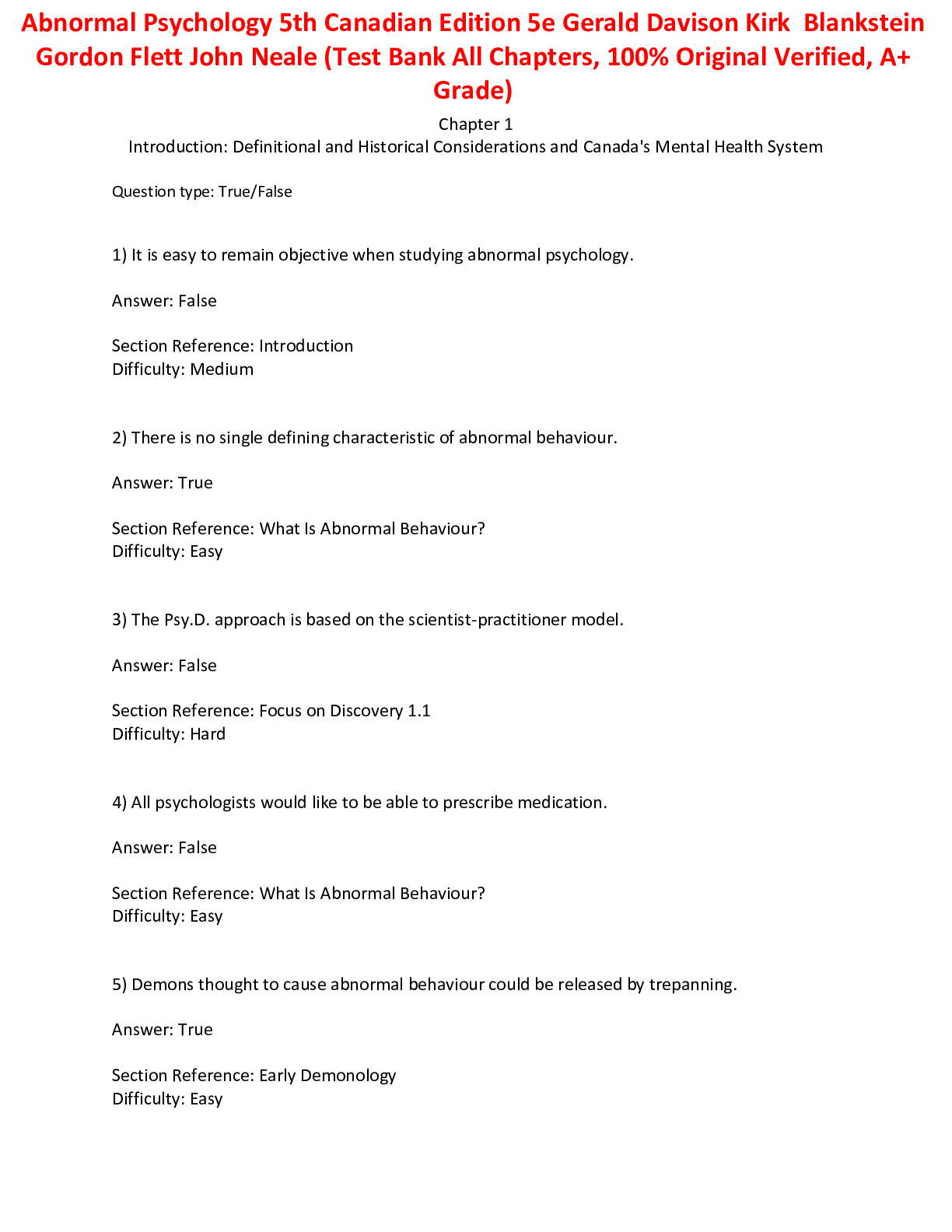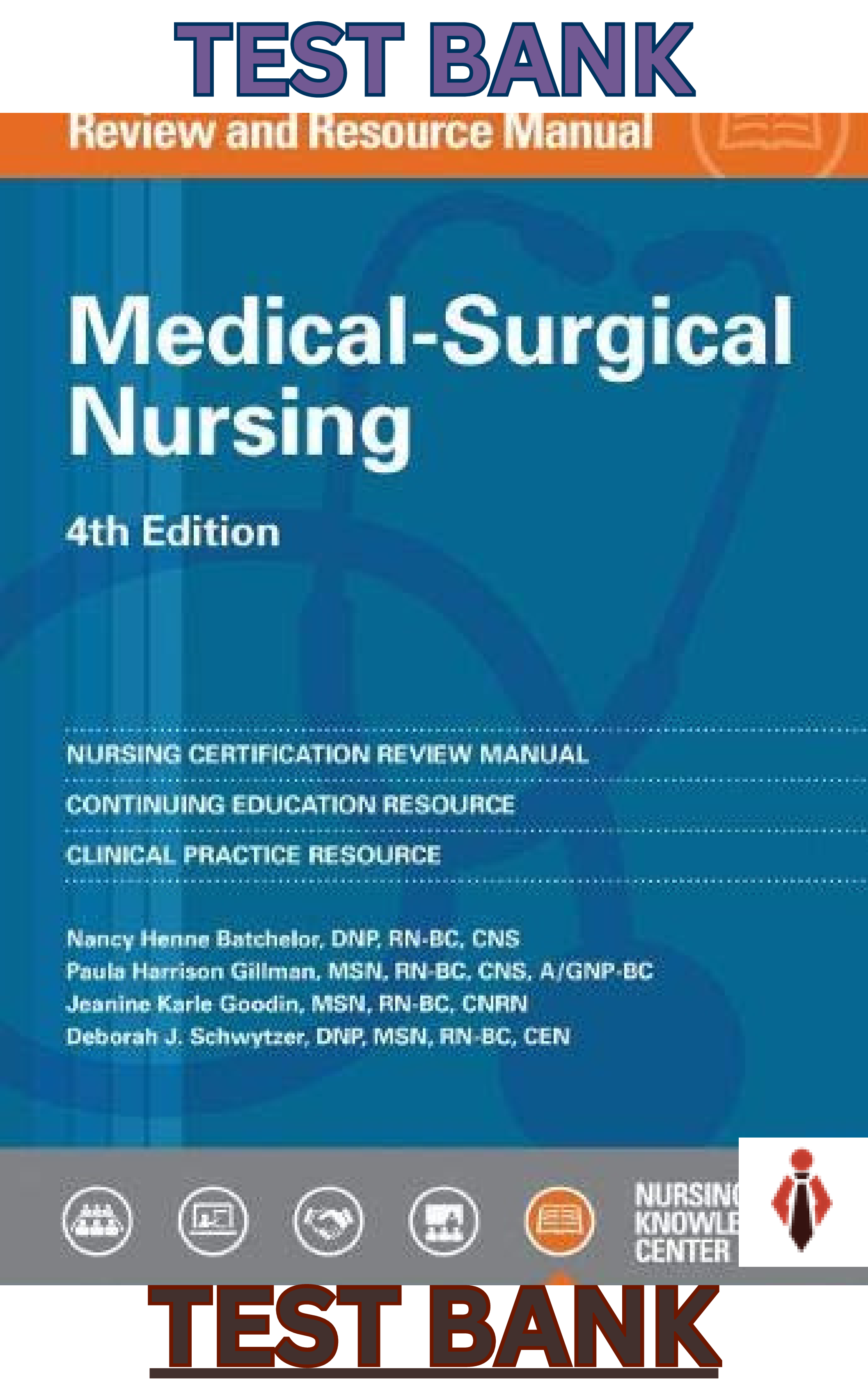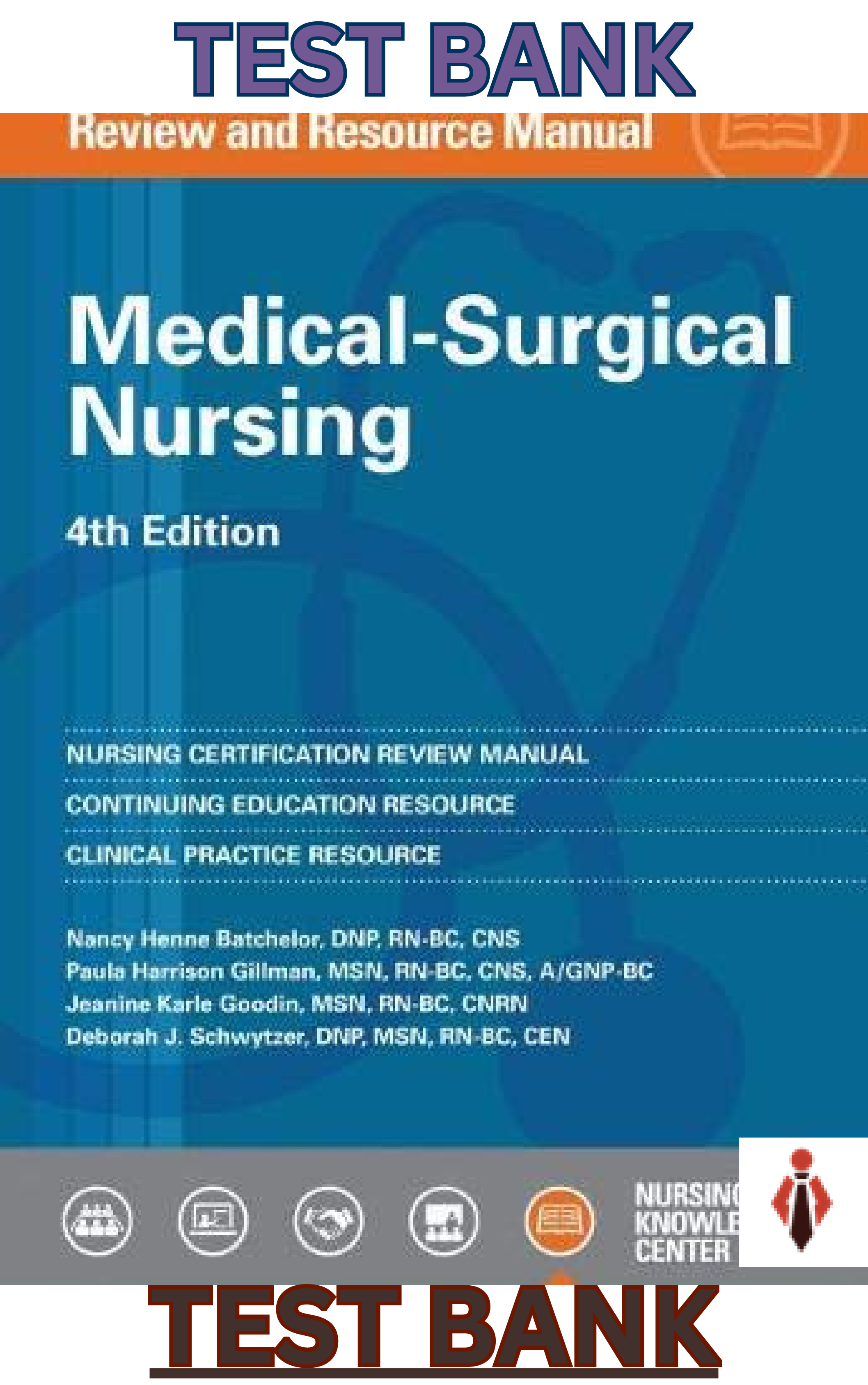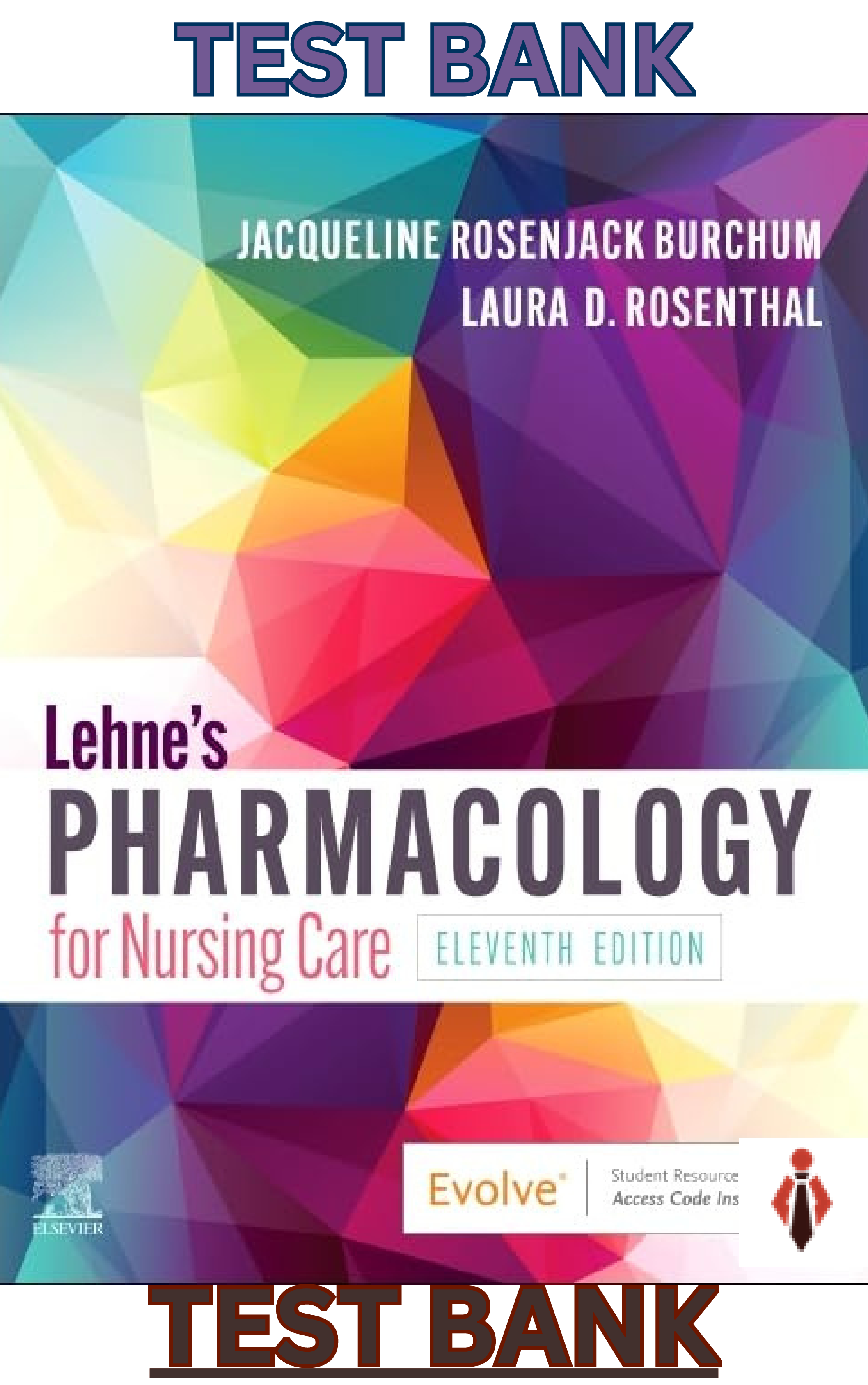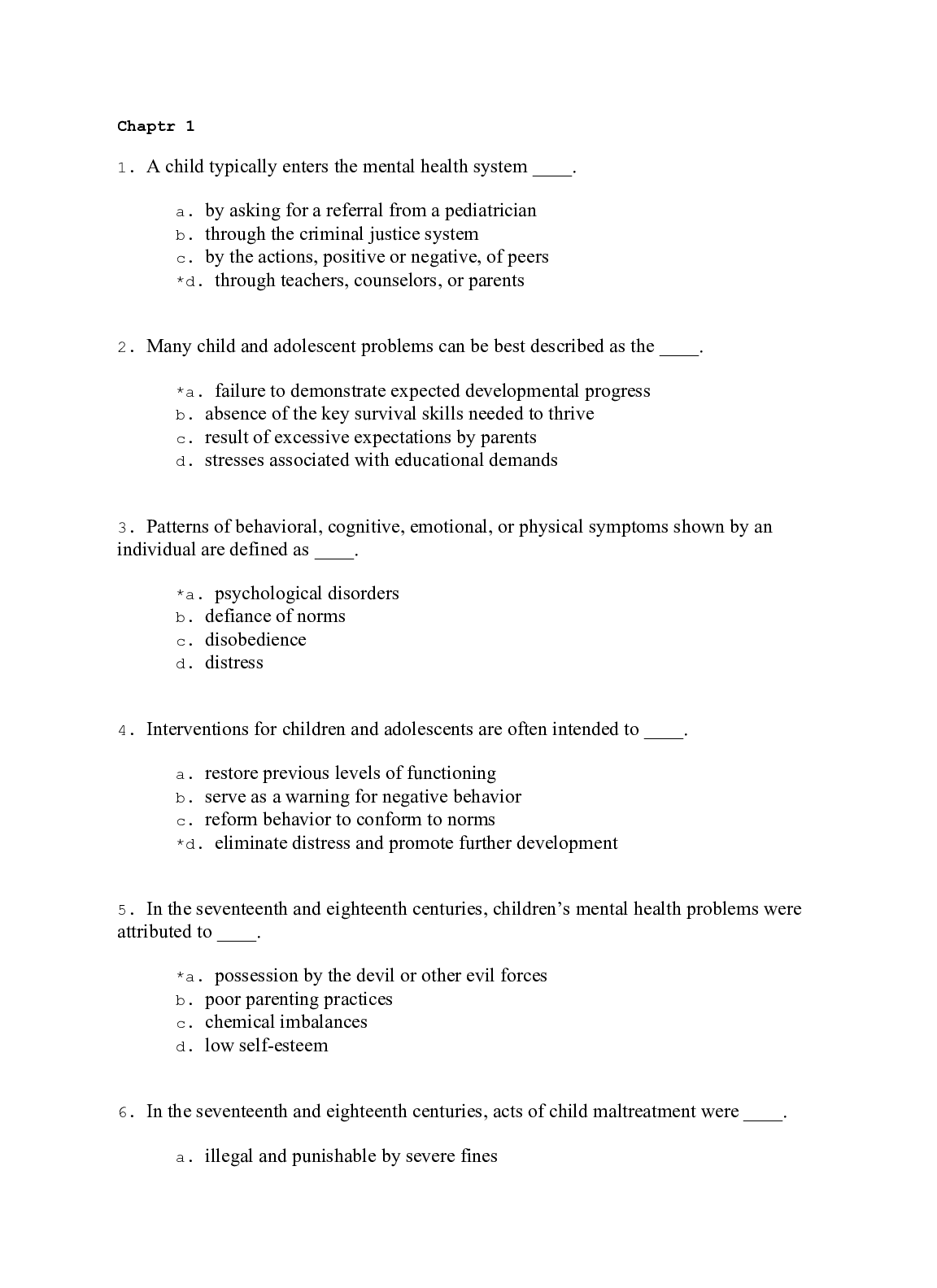*NURSING > TEST BANK > Test Bank NSG 210 Settings and Models for Nursing Care Questions & Answers and Rationale,100% CORREC (All)
Test Bank NSG 210 Settings and Models for Nursing Care Questions & Answers and Rationale,100% CORRECT
Document Content and Description Below
Test Bank NSG 210 Settings and Models for Nursing Care Questions & Answers and Rationale 1. Which of the following describes the role of the nurse as defined by Florence Nightingale? A) Helping peop... le to carry out activities that contribute to health and recovery B) Putting the patient in the best condition for nature to act upon him or her C) Diagnosing and treating human responses to actual or potential health problems D) Promoting a caring relationship that facilitates health and healing Ans: B Feedback: Florence Nightingale (1859) described the role of the nurse as putting “the patient in the best condition for nature to act upon him.” Virginia Henderson envisioned the nurse's role as helping people (sick or well) to carry out activities that contribute to health, recovery, or a peaceful death. The American Nurses Association (ANA) traditionally defined nursing as “the diagnosis and treatment of human responses to actual or potential health problems.” In response to an increased emphasis on the science of care, the ANA now acknowledges “promotion of a caring relationship that facilitates health and healing” as one of the four essential features of contemporary nursing practice. 2. Which setting has been the traditional site for the nursing work force? A) Dialysis units B) Inpatient units C) Same-day surgery units D) Clinics Ans: B Feedback: Although hospitals include all levels of outpatient areas (e.g., dialysis units, clinics, same-day surgery units, related diagnostic departments), inpatient units have been the traditional site for much of the nursing work force. 3. Which type of care is used for clients with terminal illness who have a life expectancy of less than 6 months? A) Hospice care B) Ambulatory care C) Skilled nursing care D) Intermediate care Ans: A Feedback: Hospices provide care for clients with terminal illness whose life expectancy is less than 6 months. Ambulatory care is also called outpatient care. Skilled nursing care facilities provide skilled nursing and rehabilitative care to people who have the potential to regain function but need skilled observation and nursing care during an acute illness. Intermediate care facilities are nursing homes that provide custodial care for people who cannot care for themselves because of mental or physical disabilities. 4. Freestanding apartments are an example of which type of alternative healthcare setting? A) Skilled nursing care B) Assisted living C) Congregate housing D) Boarding homes Ans: C Feedback: Congregate housing provides independent living or minimal assistance for seniors or disabled adults. Skilled nursing care facilities provide skilled nursing and rehabilitative care to people who have the potential to regain function but need skilled observation and nursing care during an acute illness. Assisted living facilities provide care to residents who need assistance with up to three activities of daily living. Boarding homes are usually small homes with individual rooms where residents pay for room and board and minimal nursing services. 5. In which setting is total care often practiced? A) Assisted living B) Intensive care units C) Boarding homes D) Congregate nursing Ans: B Feedback: Total care is often practiced in intensive care units where nurses are assigned one or two clients. Assisted living facilities provide care to residents who need assistance with up to three activities of daily living. Boarding homes are usually small homes with individual rooms where residents pay for room and board and minimal nursing services. Congregate housing provides independent living or minimal assistance for seniors or disabled adults. 6. Which of the following describes the goal of alternative care facilities? A) An RN and one or more assistive personnel care for a group of patients. B) An RN assumes all care for a small group of patients. C) There is 24-hour accountability by an RN. D) The facility provides the least restrictive living arrangement. Ans: D Feedback: The goal of alternative care facilities is to provide the least restrictive living arrangement while maintaining safety and quality. Patient-focused care uses an RN partnered with one or more assistive personnel to care for a group of clients. Total care refers to assignments in which a nurse assumes all the care for a small group of clients. In primary nursing, an RN assumes 24-hour accountability for the client's care and has total responsibility for the nursing care of assigned clients during his or her shift. 7. Which nursing theorist stated that clients are open systems in constant interaction with their environment? A) Florence Nightingale B) Virginia Henderson C) Imogene King D) Dorothea Orem Ans: C Feedback: Imogene King stated that clients are open systems in constant interaction with their environment. Florence Nightingale described the role of the nurse as putting “the patient in the best condition for nature to act upon him.” Virginia Henderson envisioned the nurse's role as helping people (sick or well) to carry out activities contributing to health, recovery, or a peaceful death that they would do for themselves if they had the necessary strength, will, or knowledge. Dorothea Orem was a proponent of the self-care deficit theory. 8. Veterans' hospitals are an example of which type of ownership? A) For-profit B) Government-owned C) Proprietary D) Nonprofit Ans: B Feedback: Veterans' hospitals are an example of government-owned healthcare institutions. For- profit agencies (proprietary) are owned and operated by corporate groups with investors and stockholders. Nonprofit institutions include universities and religious organizations. 9.A religious organization is an example of this type of ownership? A) Government-owned B) Proprietary agency C) Nonprofit agency D) Public facility Ans: C Feedback: Nonprofit institutions include universities and religious organizations. Veterans' hospitals are an example of government-owned or public healthcare institutions, which receive at least some tax support. For-profit agencies (proprietary) are owned and operated by corporate groups with investors and stockholders. 10.Which type of length of stay includes emergency department visits? A) Long-term care B) Acute care C) Short stay D) In-and-out care Ans: D Feedback: An example of in-and-out care is an emergency department visit. Long-term care provides care to residents for the remainder of their lives. Acute care occurs in hospitals where clients stay more than 24 hours but less than 30 days. Short stay provides care to clients who suffer from acute conditions or need treatments that entail less than 24 hours of care and monitoring. 11.A student nurse asks the nursing instructor, “What will my role as a nurse encompass after I graduate?” What is the best response by the nursing instructor? A) “You will take care of clients who are ill in a hospital or long-term care facility.” B) “You will care for individuals and families and play a role in health education, illness prevention, and promotion.” C) “You will care for a variety of clients of all ages when they are ill.” D) “It will all depend on where you want to work when you graduate. Nurses do different things in healthcare.” Ans: B Feedback: Nursing is concerned with caring for individuals, families, or groups. Nurses not only care for clients when they are ill but also play a significant role in health education, illness prevention, and promotion. Nurses attend to client needs related to hygiene; activity; diet; the environment; medical treatment; and physical, emotional, and spiritual comfort. Answer A only identifies a small portion of nursing and does not recognize health promotion, prevention, or education. Answer C and D are very narrow views of nursing and doesn't answer the question that the student is asking. 12. The LPN is caring for clients at the hospital's medical unit. What role does the LPN/LVN have in the care of clients on this unit? A) The LPN/LVN may provide care to clients who have a well-defined, common problem. B) The LPN/LVN may manage and coordinate the care of a group of clients. C) The LPN/LVN has a high level of competency in assessment skills. D) The LPN/LVN encourages clients and family members to develop self-care skills. Ans: A Feedback: The LPN/LVN provides care to clients under the direction of a registered nurse (RN), advanced practice nurse (APRN), or physician in a structured healthcare setting. LPN/LVNs care for clients with well-defined, common problems that often require a high level of technical competency and expertise. The other answers are all roles that an RN would have. 13. An LPN says to an RN, “I don't understand why I get paid less, yet we do the same thing here at work.” What role does the RN have in the healthcare setting that the LPN does not? A) The RN only cares for clients with well-defined, common problems. B) The RN's role is more complex and involves management and coordination of all the care provided to a group of clients. C) The RN is responsible for everything that the LPN does in the healthcare setting. D) The RN is the only provider that cares for clients with common problems that require a high level of technical competency and expertise. Ans: B Feedback: The RN's role is more complex, involving the management and coordination of all the care provided to a group of clients. LPN/LVNs care for clients with well-defined, common problems that often require a high level of technical competency and expertise. LPNs are responsible for their own actions and must work within their scope of practice. 14. The charge nurse is making assignments for a group of clients on a medical unit. When reviewing the acuity of the clients, the charge nurse assigns the RN to the clients with higher acuity levels. Why would the charge nurse assign the RN to the patient's with a higher acuity? A) LPNs do not understand how to care for clients with complex disorders. B) Assigning an LPN would allow them to provide care out of their scope of practice. C) Higher acuity clients request the services of an RN versus other care providers. D) A higher acuity client requires a greater need for highly skilled care. Ans: D Feedback: Generally, higher acuity requires a greater need for highly skilled care. Clients with complicated or high-risk surgery, massive trauma, or critical illness will be cared for in an acute care hospital, where a high level of professional, skilled, and technological care is available. RNs are instrumental in caring for these clients. LPNs may understand how to care for clients with complex disorders, but RNs are instrumental in the client care. There are no guidelines about practicing for LPNs and the acuity of clients. Clients generally do not request care by a specific provider. 15.A client who is receiving respiratory support with a tracheostomy and mechanical ventilation after a stroke is being discharged from the acute care facility. Family members state that they will not be able to care for the client at home to provide the care that is required. What type of care may this client be a candidate for after discharge? A) Long-term acute care B) Subacute care C) Intermediate care facility D) Rehabilitation care Ans: A Feedback: Clients who require ventilator support or who have other conditions that are potentially unstable but do not have rapid changes may receive care in a long-term acute care facility. Subacute care refers to care that is more intense than traditional long-term care but less intense than acute inpatient care. Intermediate care facilities (ICFs) are nursing homes that provide custodial care for people who cannot care for themselves because of mental or physical disabilities. Rehabilitation centers provide physical and occupational therapy to clients and families to help individuals regain as much independence with ADLs as possible. 16.A client is going to be in a subacute care unit for approximately 30 days. The client will require frequent assessments and periodic review of the client's progress. What role will the registered nurse have in the care of this client? A) The RN will provide direct care for the client. B) The RN will ensure that the client eats 100% of the meals. C) The RN will order the various treatments for the client. D) The RN will coordinate the client's care. Ans: D Feedback: RNs coordinate clients' care, and LPN/LVNs provide and oversee care provided by unlicensed assistive personnel (UAPs). The RN does not generally provide the direct care, and this would include overseeing meals. It is beyond the scope of practice for RNs to order treatments and medications. 17. An older adult client is being transferred to another facility in order to continue physical therapy after having a total right hip replacement. What type of facility will provide skilled nursing and rehabilitative care for this patient who will go home after the rehabilitation? A) Acute care facility B) Long-term acute care C) Skilled nursing care D) Intermediate care facility Ans: C Feedback: Skilled nursing care facilities provide skilled nursing and rehabilitative care to people who have the potential to regain function but need skilled observation and nursing care during an acute illness. Acute care facilities are for clients who have a higher level of acuity. Long-term acute care are for clients who require long-term wound care of ventilator support or who have other conditions that are potentially unstable but do not have rapid changes. Intermediate care facilities provide custodial care for people who cannot care for themselves because of mental or physical disabilities. 18. An LPN just received her license to practice and applied for a position at a skilled nursing care facility. While being interviewed, the LPN asks what her role will be at the facility. What is the best answer by the interviewer? A) “You will be organizing and coordinating the care of the clients.” B) “You will be participating in the care of the clients.” C) “You will be in charge of a unit and have 24-hour accountability.” D) “You will be responsible for developing and implementing a plan of care for the clients.” Ans: B Feedback: An RN must be in charge of client's care, although other healthcare providers, particularly LPN/LVNs, participate in their care. The other answers are all under the scope of practice of an RN. 19.A client who has mental disabilities has recently lost his remaining parent and is unable to care for himself at home. What facility would best meet the needs of this client? A) Acute care facility B) Rehabilitation care C) Intermediate care facility D) Ambulatory care Ans: C Feedback: Intermediate care facilities (ICFs) are nursing homes that provide custodial care for people who cannot care for themselves because of mental or physical disabilities. Clients must meet specific criteria related to an inability to meet their own activities of daily living (ADL). Rehabilitation centers provide physical and occupational therapy to clients and families to help individuals regain as much independence with ADLs as possible. Acute care facilities care for clients with a higher acuity level. Ambulatory care is also referred to as outpatient care and is a short stay. 20.A client experienced a stroke approximately 2 weeks previously and has residual left side hemiparesis. What facility would best meet the needs of this client in order to help regain independence with activities of daily living? A) Rehabilitation care B) Hospice care C) Ambulatory care D) Acute care Ans: A Feedback: Rehabilitation care provides physical and occupational therapy to clients and families to help individuals regain as much independence with ADLs as possible. Hospices provide care for clients diagnosed with a terminal illness whose life expectancy is fewer than 6 months. Ambulatory care is also a short-term outpatient care. Acute care facilities are facilities that provide care to clients of higher acuity. 21.A client has end-stage chronic obstructive pulmonary disease (COPD) and is terminally ill. The family wants the client to spend her last days in a facility that will be able to keep the patient comfortable and control her severe dyspnea. What facility will meet the needs of the client and family? A) Rehabilitation care B) Hospice care C) Intermediate care facilities D) Ambulatory care Ans: B Feedback: Hospice provides care for clients diagnosed with a terminal illness whose life expectancy is fewer than 6 months. Hospices allow terminally ill clients to live as fully as possible while managing pain, discomfort, and other symptoms. Rehabilitation centers provide physical and occupational therapy to clients and families to help individuals regain as much independence with ADLs as possible. Intermediate care facilities (ICFs) are nursing homes that provide custodial care for people who cannot care for themselves because of mental or physical disabilities. Ambulatory care is also outpatient care. 22.Home health nurses will be caring for a debilitated client in the home. The client will be discharged from an acute care facility to the care of family members. The client will require twice daily wound care for a large sacral decubitus ulcer. What will be the goal of the home health nurses in the care of this client? A) To have the client admitted to a long-term care facility if the ulcer does not heal in a timely manner B) To have client come to the home care agency twice daily for dressing changes C) To continue to see the patient twice daily for dressing changes until the wound heals D) To encourage family members to develop self-care skills and perform dressing changes Ans: D Feedback: The RN encourages clients and family members to develop self-care skills, with support from community resources. The home health nurse's goal is to allow the client to be cared for in their home and not in a long-term care facility if that is not what the client wishes. The client's condition does not enable self-care. The goal for the family will be to perform dressing changes and the nurse will continue to monitor the condition of the wound. 23.A client is living in congregate housing and informs the LPN at the clinic that they do not like living there. When the nurse asks why they are unhappy with current living arrangements, the client states, “It is a nice place but I am unable to do anything because I hardly have money for my medicines or food.” What is an issue related to congregate housing? A) Residents may find that congregate housing is unaffordable. B) Residents may not have any other resources to purchase extra services or goods. C) Residents are not assured of appropriate housing and may be evicted at any time. D) Residents must be financially able to participate in outside activities. Ans: B Feedback: Congregate housing is affordable, but residents may not have any other resources to purchase extra services or goods. They are assured of appropriate housing but may lack the resources, ability, or opportunity to participate in outside activities. 24.A client who is mentally disabled is working at an adult activity center. The client is unable to live independently, and the family member they are living with can no longer assist with supervised care. What option for living arrangements would be ideal for this person? A) Congregate housing B) Boarding home C) Long-term acute care facility D) Acute care facility Ans: B Feedback: Boarding homes usually are small homes with individual rooms where residents pay for room and board and minimal nursing services. Residents often share rooms, have a common dining area for all meals, and also oversee employment for disabled adults and provide a stable environment for those who cannot live independently. Congregate housing provides independent living for seniors or disabled adults who need minimal to no assistance. Long-term care facilities are for clients who require long-term wound care or ventilator support or who have other conditions that are potentially unstable but do not have rapid changes. Acute care facilities are for those clients who are of high illness acuity. 25.A client is unable to care for her needs and requires assistance with activities of daily living. The son calls the clinic and informs the LPN that he wants his mother to be able to remain in her home but must work and is unable to care for her 24 hours per day. What options can the LPN suggest for the care of his mother? A) Employ private duty nurses to care for the parent. B) He must admit his mother to a nursing home. C) He will have to quit his job and stay home to care for her. D) Take her to an adult day care center. Ans: A Feedback: A modern version of the case method is private duty nurse where care is provided in the home and many household duties are performed as well. The son does not have to admit his parent to the nursing home if he chooses not to, and he will not have to quit his job if he can have a nurse come into the home. Adult day care would not assist with after-hour care. 26. The LPN has been assigned to a medical floor and to do all of the dressing changes and other treatments. The RN will make the rounds with the physicians, transcribe orders, and administer all of the IV medications. Another LPN will administer medications. What type of nursing is this group providing? A) Team nursing B) Total care C) Functional nursing D) Primary nursing Ans: C Feedback: Functional nursing is a task-oriented method, and distinct duties are assigned to specific personnel. Total care refers to assignments in which a nurse assumes all the care for a small group of clients. In team nursing, teams made up of an RN team leader, other RNs, LPN/LVNs, and nursing assistants provide care to a group of clients. Primary nursing is when the RN assumes 24-hour accountability for the client's care and has total responsibility for the nursing care of assigned clients during his or her shift. 27. The LPN is part of a group of nurses that has an RN team leader as well as another LPN and two nursing assistants who will be providing care to a group of clients. What type of nursing method is this considered? A) Functional nursing B) Total care C) Case method D) Team nursing Ans: D Feedback: Team nursing is composed of an RN team leader, other RNs, LPN/LVNs, and nursing assistants who provide care to a group of clients. Functional nursing is a task-oriented method where everyone in the group is assigned to specific tasks. Case method is the same as private duty nursing. Total care refers to assignments in which a nurse assumes all the care for a small group of clients. 28. The RN is assuming all of the care for a small group of clients, and an LPN is assigned to another group of clients with a lower acuity. What type of nursing is this considered? A) Total care B) Team nursing C) Functional nursing D) Primary nursing Ans: A Feedback: Total care refers to assignments in which a nurse assumes all the care for a small group of clients. Team nursing are teams made up of an RN team leader, other RNs, LPN/LVNs, and nursing assistants, and they provide care to a group of clients. Functional nursing is a task-oriented method of nursing. Primary nursing is when an RN assumes 24-hour accountability for the client's care and has total responsibility for the nursing care of assigned clients during his or her shift. 29. An RN has been assigned to care for three clients on the medical unit and will assume 24- hour accountability for those clients' care. When the nurse goes off duty, the plan of care will be continued by a secondary nurse. What type of nursing model is this considered? A) Team nursing B) Case method C) Functional nursing D) Primary nursing Ans: D Feedback: In primary nursing, the RN assumes 24-hour accountability for the client's care and has total responsibility for the nursing care of assigned clients during his or her shift. Team nursing is made up of an RN team leader, other RNs, LPN/LVNs, and nursing assistants who provide care to a group of clients. The case method is the same as a private duty nurse. In functional nursing, distinct duties are assigned to specific personnel. 30. The nurse manager of a telemetry unit is considering changing from a team model of nursing to a primary nursing model. When considering this decision, what advantage does the manager understand the primary nursing model brings to nursing care? A) The RN will partner with one or more assistive personnel to care for a group of clients. B) Caregivers see to all their clients' needs, thus providing holistic and comprehensive care. C) Tasks are divided, and clients see several people during the shift. D) The RN will be the team leader and direct the care that is provided by all of the other personnel. Ans: B Feedback: In primary nursing, an RN assumes 24-hour accountability for the client's care and has total responsibility. An advantage is that the client has a caregiver who sees to all of his or her needs and who provides holistic and comprehensive care. Option A refers to a patient- care focused model. Option C refers to a total care model, and option D is a team approach. 31.A hospital unit has been using a functional nursing model for delivery of care for several years. The manager has been discussing with the staff the idea of a change to total care because functional nursing has some disadvantages to the clients. What disadvantage is the manager referring to? A) It is expensive because it only uses RNs. B) Some nurses work harder than others to provide care. C) It fragments care and is confusing for the clients. D) Nurses are accountable for the client's care 24 hours per day. Ans: C Feedback: Although efficient, functional nursing fragments care and is confusing for clients. Primary nursing is expensive because it uses RNs only. Nurses are designated certain tasks if functional nursing is employed, so the care is divided. Nurses are accountable for client care in a primary nursing model. 32.A client is admitted to an acute care facility after having a stroke. The client will require a variety of healthcare services throughout the hospital stay as well as coordination of care prior to discharge. What referral would be a priority for overseeing the client's care? A) Case management B) Physical therapy C) Occupational therapy D) Dietary services Ans: A Feedback: The person responsible for overseeing the client's care, usually an RN with a bachelor's or master's degree or another highly experienced health professional, is called the case manager. Physical therapy, occupational therapy, and dietary services are all important care disciplines but do not encompass all of the client's needs. 33.A client in an acute care facility is assigned a case manager to oversee and coordinate care. What important function does a case manager have? A) Provide early, thorough discharge planning. B) Make sure the client is administered medications. C) Provide care to the client who is terminally ill and has less than 6 months to live. D) Make home visits to see that the patient is taken care of after discharge. Ans: A Feedback: An important function of case managers is to provide early, thorough discharge planning. The case manager is not responsible for the administration of medications. Hospice care provides care to the client who is terminally ill. The case manager oversees the care of the clients while they are hospitalized. Referrals to community agencies and home healthcare will be made for home visits. 34.A client arrives at the physician's clinic in order to receive care for a cough and fever. What type of healthcare institute classification is this client attending? A) Short stay B) Acute care C) Long-term care D) In-and-out care Ans: D Feedback: Contact with the client is measured in minutes versus hours. Typical examples are office visits, emergency department visits, and therapy sessions with in-and-out care. Short stays provides care to clients who suffer from acute conditions or need treatments that require fewer than 24 hours of care and monitoring. Long-term care provides care to residents for the remainder of their lives. Acute care traditionally occurs in hospitals where clients stay more than 24 hours. 35.A client will be discharged from an acute care facility but will require home health services to assess the need for assistive devices to aid in activities of daily living and identify issues related to fine motor movements and muscle retraining after a stroke. What referral will home health services make? A) Physical therapy B) Homemakers C) Occupational therapy D) Speech therapy Ans: C Feedback: Occupational therapy will assess the need for assistive devices to aid in activities of daily living and identify issues related to fine motor movements and muscle retraining. Physical therapy will assess the client's mobility after orthopedic surgery, injury, or stroke. Homemaker services will clean, do laundry, and shop for groceries. Speech therapy will provide rehabilitation to clients with speech or swallowing disorders. [Show More]
Last updated: 1 year ago
Preview 1 out of 25 pages
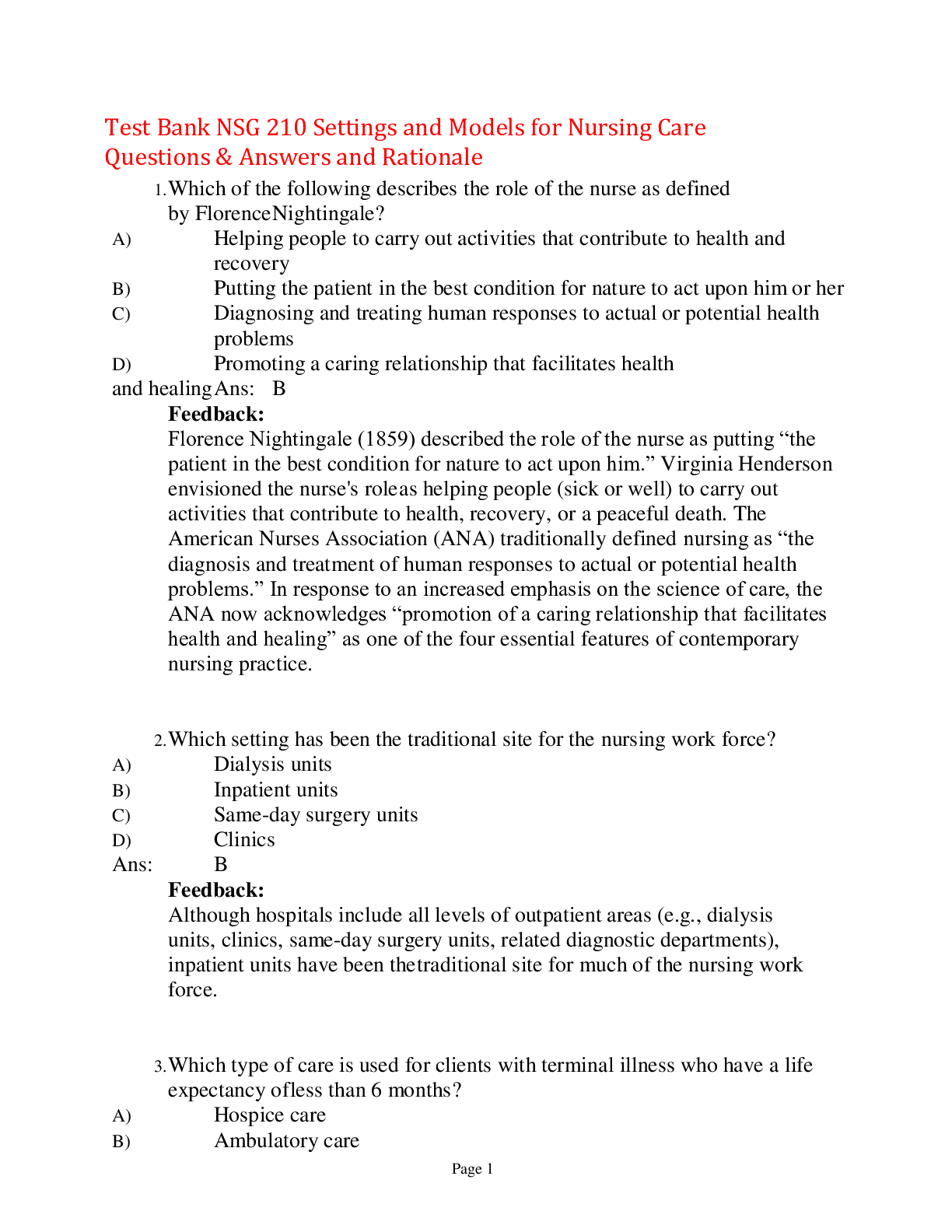
Reviews( 0 )
Document information
Connected school, study & course
About the document
Uploaded On
Sep 14, 2022
Number of pages
25
Written in
Additional information
This document has been written for:
Uploaded
Sep 14, 2022
Downloads
0
Views
28

